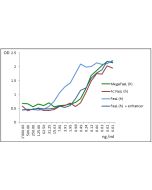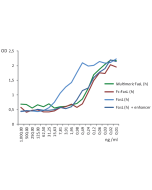Cookie Policy: This site uses cookies to improve your experience. You can find out more about our use of cookies in our Privacy Policy. By continuing to browse this site you agree to our use of cookies.
Chimerigen
DcR3 (human):Fc (human) (rec.)

| Product Details | |
|---|---|
| Synonyms | Decoy Receptor 3; Tumor Necrosis Factor Receptor Superfamily Member 6B; TNFRSF6B; M68 |
| Product Type | Protein |
| Properties | |
| Source/Host | CHO cells |
| Sequence |
The extracellular domain of human DcR3 (aa 24-300) is fused to the N-terminus of the Fc region of human IgG1. |
| Crossreactivity | Human |
| Purity | ≥98% (SDS-PAGE) |
| Endotoxin Content | <0.06EU/μg protein (LAL test; Lonza). |
| Reconstitution |
Reconstitute with 100 µl sterile water. Add 1X PBS to the desired protein concentration. |
| Formulation | Lyophilized from 0.2μm-filtered solution in PBS. |
| Protein Negative Control | |
| Other Product Data |
NCBI reference O95407: DcR3 (human) |
| Declaration | Manufactured by Chimerigen. |
| Shipping and Handling | |
| Shipping | BLUE ICE |
| Short Term Storage | +4°C |
| Long Term Storage | -20°C |
| Handling Advice |
Avoid freeze/thaw cycles. Centrifuge lyophilized vial before opening and reconstitution. |
| Use/Stability |
Stable for at least 1 year after receipt when stored at -20°C. Working aliquots are stable for up to 3 months when stored at -20°C. |
| Documents | |
| Product Specification Sheet | |
| Datasheet |
 Download PDF Download PDF |
Decoy receptor 3 (DcR3; TNFRSF6B; M68) is a member of the TNF receptor superfamily. DcR3 shares sequence identity with OPG (31%), TNF-RII (29%) and Fas (17%) and is expressed in a variety of different tissues and at high levels in many malignant tumors. Ligands of DcR3 include Fas ligand, homologous to lymphotoxin showing inducible expression and competing with HSV glycoprotein D for herpes virus entry mediator (a receptor expressed by T lymphocytes), TNF-like molecule 1A and heparan sulfate proteoglycans. DcR3 modulates the function of T cells, dendritic cells and macrophages. DcR3/Fc fusion proteins can bind to human and mouse B cells and suppress the activation of B cells.








